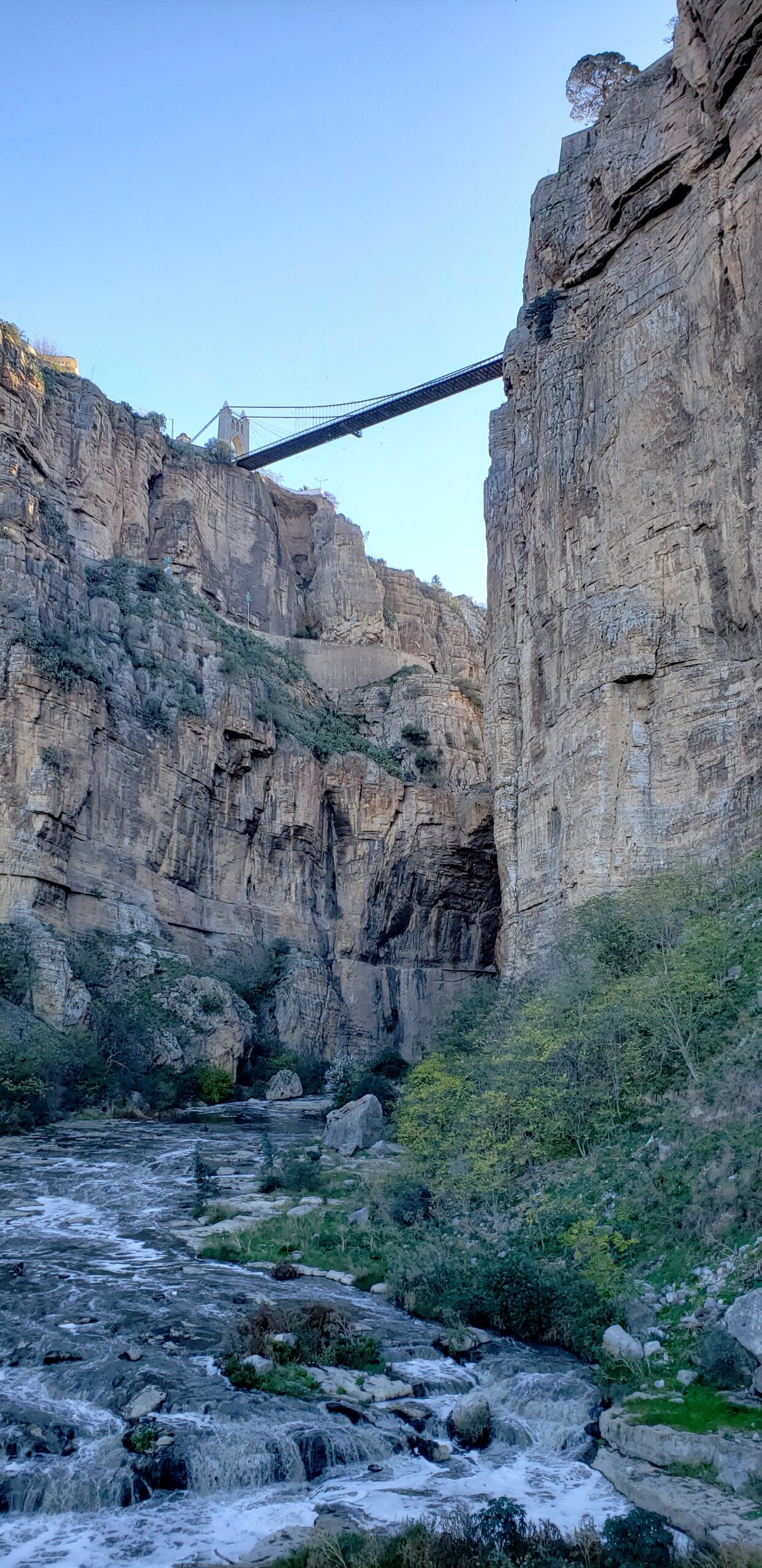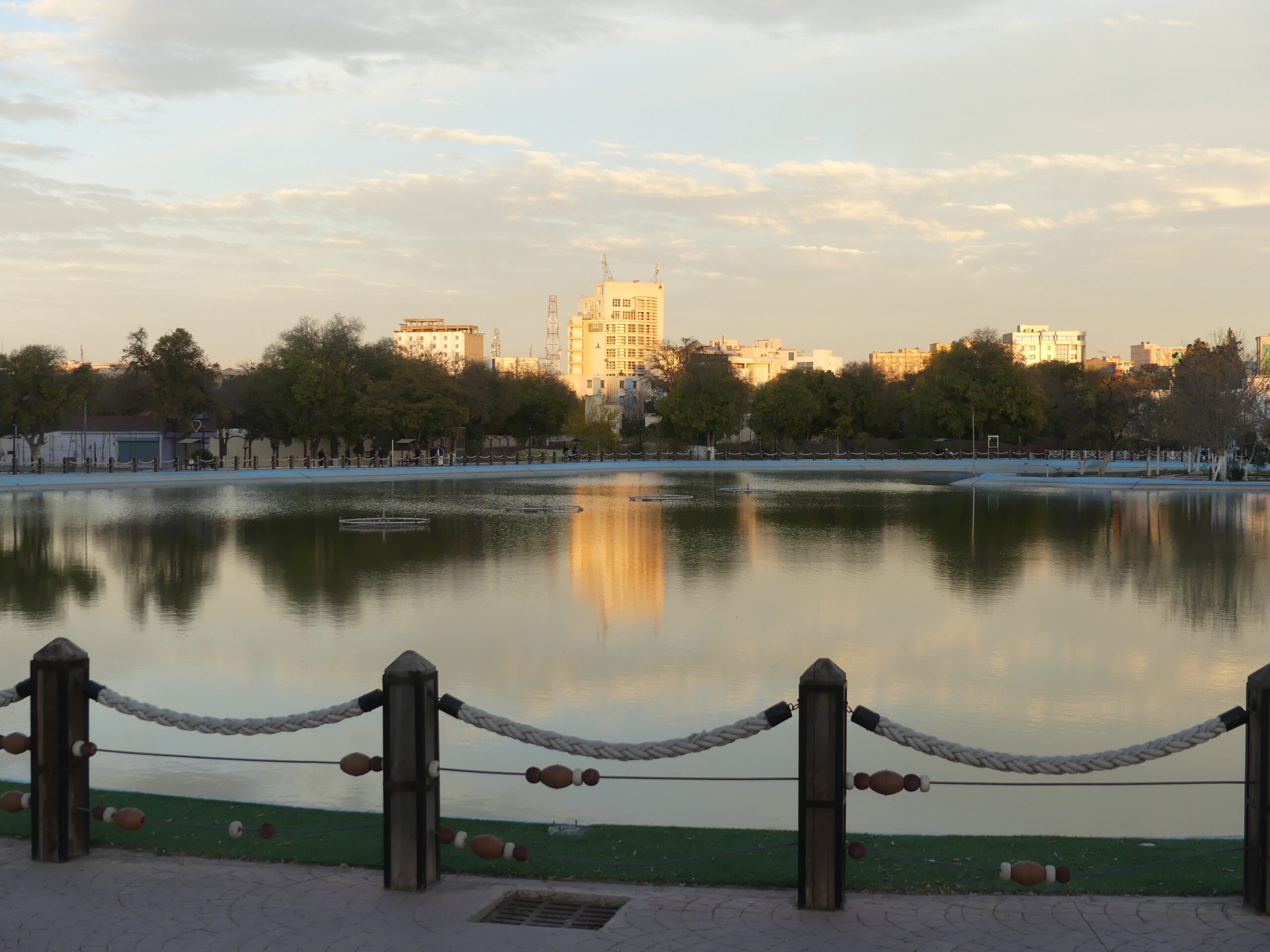Constantine is known as the City of Bridges for it needs at least nine bridges to traverse. But it could just as well be called the City of Ravines for the chasms traversed by the bridges, the City of Rock for the huge outcrops on which its buildings perch, or the City of Viewpoints for the innumerable vistas over the rippling landscape below. For 500 years, the Ottomans and the French colonists crafted today’s city. But the rock, ravines, and vistas – the reason for all eight bridges – have remained the same.
Bridges and Ravines
We awoke to this view every morning, with the newer colonial town to the left and the old city just behind the long Sidi Rached bridge of 27 arches. Toward the back there is also an unoccupied promontory. Notice the tiny white mosque balanced precariously on an outcrop beneath the longest arch. Out of view to the right is the newest bridge in Constantine, a non-Calatrava Calatrava-like bridge that runs over a kilometer long.

Our favorite bridge over the Rhumel River gorge is this 100-year old suspension bridge, Mellah Slimane, whose stanchions look a bit like a slimmer version of the Brooklyn Bridge’s. Only foot traffic on this one, which connects a busy thoroughfare on the far side to the old medina at the near side. The medina’s rocky ledge looms over the bridge, some four stories (20 meters) higher. After bouncing gingerly on the bridge, we chose to climb the stairs to the top and skip the line for the elevator.
Seen from a distance, in this reverse view, the pedestrian-only Mellah Slimane suspension bridge clearly spans an impressive part of the main gorge. A host of buildings in the medina seem to be elbowing their way to the edge for the view.
You can walk or drive to the Sidi M’Cid bridge, which crosses from old town to new town, by way of several tunnels cut into the rock, each of which offers a different panorama. To its right, the falls flow under a roadway far below and the lovely landscape stretches to the horizon.
This dizzying view comes from an opening in the tunnels carved through rock to reach the Sidi M’Cid bridge. We are peering down into the falls of the Rhumel River as it emerges from the city’s gorge. The next photo shows the view from the road bridge below.
The reverse view of the Rhumel River gorge, from below, with that Sidi M’Cid bridge spanning it.
Looking toward Constantine over the main gorge from Sidi M’Cid bridge with the Bab El Kantra Bridge farther on. The latter was the oldest one we walked, a mid-19th century French transformation of an earlier 18th century Ottoman bridge. The city, named for Emperor Constantine in the 4th century, somehow retained its name throughout numerous imperial changes.
Old and New Constantine
Ahmed Bey was the last Ottoman governor of Constantine until 1848, a few years after the French occupied the area. In his palace, there are hundreds of cedar doors to attract the eye, as well as elegant marble columns filling the spacious interior. But we were especially charmed by the wall containing the Bey’s travel blog of images from important places he had visited. This is Istanbul, for example, the Ottoman capital city.
Though dating from the mid-19th century, the palace of the last Ottoman governor is still in very good condition. Located next to the old town or medina, it features this and two other lush gardens that define different living and greeting sections of the palace.
Several long streets run parallel thru the busy medina, each connected by narrow passageways like this.
The impressive façade of newer French colonial buildings arcs away from the old medina. The adjacent plazas contain formidable bank buildings and a grand theatre. You wouldn’t think it now, but Constantine could also be considered the City of Malaria, for here in 1880 a French doctor made his Nobel-prize winning discovery of the disease’s cause.
This stunning view of the flowing landscape and rocky walls supporting Constantine is at a French memorial arch perched on another rocky outcrop. Though it still lists the hundreds of Constantine residents of all faiths who died in World War I while fighting for France, it’s informally repurposed as a memorial to the fighters for independence against France.
This is the interior of the Abdel Kader mosque, the largest and newest in the city, as massive as this open space implies. Most older mosques are closed to non-Muslims. We were allowed to marvel at this one, though Nancy was asked to wear a scarf and robe to enter. Unlike in older mosques, women have exclusive access to an equally large space for prayer, socializing, and study. Prayer times are posted in LCD lights on the wall.
In a narrow array of lanes tucked below the hotel district, hundreds of craftsmen painstakingly pound and etch copper by hand to make enormous serving pieces and decorative items.
We found one young artisan that also made copper teaspoons, perfect for Nancy’s international spoon collection. He happily personalized it in a few minutes, carving Constantine ALG on the back, with two hearts.
Other Northern Cities
During our visit, we stayed in two other towns in the northern part of Algeria while touring the region: Setif and Batna. They aren’t really “touristic” in the dramatic way of Constantine, for there are few historical sites or spectacles within them.
Pleasant boulevards and shopping districts cross near Setif’s magnificent museum and large shopping mall. This is the anomalous highlight on one street, an 1898 French statue of a naked nymph at the site of a natural spring. Toss a coin, we’re told, and you will return to Setif.
Also, in the center city of Setif, a large formal park invites residents all day and into the evening, particularly at the easy-going amusement center connected to it. We rode the modestly thrilling roller coaster.
Batna is renowned for its broad plazas and extensive spice market. If you can’t find it there, you don’t really want it. But it’s also known for its many tea spots, whether cafe-like or informal stalls like this one, with added entertainment value. The tea is very intensely strong, so don’t skip the sweetener.
The Batna theatre anchors this end of a long pedestrian plaza that entices residents as well as visitors, even in cold weather.
In each of these towns, we enjoyed something fundamental within Algeria today, the appealing urban lifestyle of its people.
(To enlarge any picture above, click on it. Also, for more pictures from Algeria, CLICK HERE to view the slideshow at the end of the itinerary page.)






















